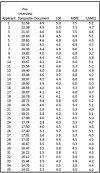Prioritizing the Interview in Selecting Resident Applicants: Behavioral Interviews to Determine Goodness of Fit
- PMID: 34722866
- PMCID: PMC8552388
- DOI: 10.1177/23742895211052885
Prioritizing the Interview in Selecting Resident Applicants: Behavioral Interviews to Determine Goodness of Fit
Abstract
From our initial screening of applications, we assess that the 10% to 15% of applicants whom we will interview are all academically qualified to complete our residency training program. This initial screening to select applicants to interview includes a personality assessment provided by the personal statement, Dean's letter, and letters of recommendation that, taken together, begin our evaluation of the applicant's cultural fit for our program. While the numerical scoring ranks applicants preinterview, the final ranking into best fit categories is determined solely on the interview day at a consensus conference by faculty and residents. We analyzed data of 819 applicants from 2005 to 2017. Most candidates were US medical graduates (62.5%) with 23.7% international medical graduates, 11.7% Doctors of Osteopathic Medicine (DO), and 2.1% Caribbean medical graduates. Given that personality assessment began with application review, there was excellent correlation between the preinterview composite score and the final categorical ranking in all 4 categories. For most comparisons, higher scores and categorical rankings were associated with applicants subsequently working in academia versus private practice. We found no problem in using our 3-step process employing virtual interviews during the COVID pandemic.
Keywords: ERAS (Electronic Residency Application Service); GME (graduate medical education); NRMP (National Resident Matching Program); applicants; behavioral interview; residency.
© The Author(s) 2021.
Conflict of interest statement
Declaration of Conflicting Interests: The author(s) declared no potential conflicts of interest concerning the research, authorship, and publication of this article.
Figures



References
-
- Bore M, Munro D, Powis D. A comprehensive model for the selection of medical students. Med Teach. 2009;31:1066–1072. doi:10.3109/01421590903095510 - PubMed
-
- Dowell J, Lumsden MA, Powis D, et al. Predictive validity of the personal qualities assessment for selection of medical students in Scotland. Med Teach. 2011;33:e485–e488. doi:10.3109/0142159x.2011.599448 - PubMed
-
- Bernardi RA. Associations between Hofstede’s cultural constructs and social desirability response bias. J Bus Ethics. 2006;65:43–53. doi:10.1007/s10551-005-5353-0
-
- Hofstede G. What did GLOBE really measure? Researchers’ minds versus respondents’ minds. J Int Bus Stud. 2006;37:882–896. doi:10.1057/palgrave.jibs.8400233
-
- Hofstede G. Asian management in the 21st century. Asia Pac J Manag. 2007;24:411–420. doi:10.1007/s10490-007-9049-0
LinkOut - more resources
Full Text Sources

